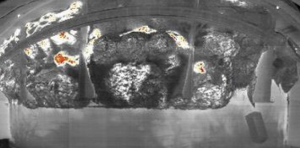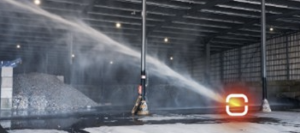In an increasingly networked and automated world, fire protection is benefiting from video and thermography-based fire detection, an innovative technology that offers unprecedented possibilities in terms of speed and accuracy of fire detection. Early fire detection is not only a safety-related aspect, but often crucial for preventing economic damage and environmental consequences. Modern camera systems for video and thermography-based fire detection, on the other hand, enable fast, reliable, and precise detection of fire developments – even before they are visible to humans or can be measured using conventional methods.
Video-based fire detection uses conventional and specially equipped surveillance cameras to analyze visual information in real time. Image processing algorithms automatically detect even the smallest signs of ignition, such as changes in air flow, as well as characteristic features of fires, such as flames, smoke development, or abrupt changes in light. Detection is software-supported, day and night, using infrared cameras or sensitive low-light sensors.
Thermography-based fire detection measures infrared radiation to detect temperature changes on surfaces or in the environment. These thermal imaging cameras register unusual heat patterns or localized temperature increases that indicate the early stages of a fire. This means that the alarm is triggered immediately and well before any visible smoke or flames appear.

Video-based fire detection systems detect fire and smoke even in environments with difficult lighting conditions and at great distances. Image credit: Siemens AG [FURTHER INFORMATION]

Thermography-based camera systems display the temperatures of the detected objects in a thermal image and show them across the entire detection area. Image credit: Orglmeister Infrarot-Systeme GmbH & Co. KG [FURTHER INFORMATION]

Thermography-based camera systems display the temperatures of the objects detected in a thermal image and show them across the entire detection area. Image credit: Dias Infrared GmbH [FURTHER INFORMATION]
Immediate and reliable fire detection even in challenging environments
Video and thermography-based fire detection systems are particularly suitable for open or expansive areas. Typical areas of application include forests and other expansive natural areas such as deserts, as very large areas can be monitored simultaneously. In times of climate change, video and thermography-based fire detection offers an excellent opportunity to detect and combat forest fires in a timely manner. Industrial facilities such as oil refineries and manufacturing halls also benefit from this technology, as they often have high fire loads and complex spatial structures. In addition, video and thermography-based fire detection can be used very effectively in recycling centers or in halls for storing hazardous materials.
Video and thermography-based fire detection offers a range of significant opportunities and potential for modern fire protection. A key advantage is the early and locally precise detection of fire developments, enabling a faster response and averting damage. In addition, the technology enables precise visual verification by security personnel, allowing a reliable assessment of the situation directly on the screen. Thanks to the possibility of scalable integration into existing networks, multiple areas can be monitored simultaneously and efficiently – even over long distances. Even in areas with extreme weather conditions or strong drafts, the technology’s detection performance remains consistently high. In addition, continuous video transmission is not only used for real-time monitoring, but can also be used for detailed documentation and subsequent analysis of fire causes and developments.
Video- and thermography-based fire detection also allows continuous status monitoring, even in dark or smoky environments. It can be integrated into existing control systems and used for preventive maintenance. Critical temperatures can be evaluated automatically, which often prevents fires before they start. Mobile cameras, such as drones for temporary surveillance, are also available on the market and can be used flexibly.

Video-based fire detection is already in use today in production areas, among other places. Image credit: Bosch Security Systems [FURTHER INFORMATION]
Use of artificial intelligence – a new level of fire detection
The use of artificial intelligence (AI) takes both technologies to a new level. AI-supported algorithms analyze large amounts of data in real time and recognize patterns that are barely discernible to humans. In video-based fire detection, AI improves the differentiation between real fire events and harmless visual disturbances such as fog, dust, or light reflections. Machine learning also allows for better interpretation of smoke or flame movement patterns.
In thermography-based fire detection, AI is used to evaluate temperature patterns over longer periods of time. Systems learn which temperature increases are “normal” – e.g., due to machine operation – and when there is an anomaly that indicates a risk. This intelligent analysis significantly reduces the number of false alarms, while at the same time the detection rate of dangerous developments is extremely high. AI is also used in video-based fire detection to quickly and accurately detect individual sources of fire, even in environments with difficult lighting conditions and at great distances.
A key component for the successful use of these technologies is the targeted training of artificial intelligence. This involves the use of extensive data sets containing both real and simulated fire events. Artificial intelligence uses this information to learn how to identify typical visual or thermal signatures of a fire and reliably distinguish them from non-critical situations. It is important to confront the AI with a variety of different scenarios, environmental conditions, and lighting conditions in order to ensure the highest possible robustness and adaptability in later use. This continuous training ensures that AI-based systems function reliably even under changing conditions and can detect new hazardous situations at an early stage.

The precise detection of a fire source forms the basis for automated responses such as the targeted activation of an extinguishing system. Image credit: Orglmeister Infrarot-Systeme GmbH & Co. [FURTHER INFORMATION]
Outlook
Overall, video- and thermography-based fire detection systems offer a new dimension in fire detection. Their strengths lie in particular in the early, precise, and often autonomous detection of fire events. Supported by artificial intelligence, false alarms can be reduced and response times significantly shortened. These technologies are already an indispensable element of effective fire protection, particularly in safety-critical areas with high property values or high population density, as well as in extensive natural areas such as forests or in industrial halls used for storing hazardous materials.

